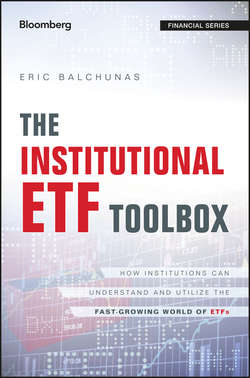Читать книгу The Institutional ETF Toolbox - Balchunas Eric - Страница 15
На сайте Литреса книга снята с продажи.
SECTION I
The ETF Phenomenon
CHAPTER 1
Why Are ETFs So Popular?
Standardization
ОглавлениеWe like it when things are standardized. Whether it is USB ports or gas pumps, it is easier when it works the same way regardless of other variables. When it comes to investing, ETFs have standardized every asset class so that they trade like equities. Investors love the fairness and price transparency of equity investing on a stock exchange. ETFs have simply equity-ized every type of investment.
For example, bonds don’t have a common exchange. They trade over the counter (off exchange) in relatively opaque markets, whereas bond ETFs trade like stocks. Some other assets that have been standardized by ETFs include physical gold, oil futures, swap agreements, currencies, and hedge fund strategies. All of these things and more can now be bought and sold on a stock exchange just like shares of General Electric. This has standardized investing, and even more importantly, it has created another venue where investors can buy or sell the ETF’s underlying exposures
While this standardization is mostly hailed as a breakthrough in convenience, it has also brought with it a few concerns. Just like Jurassic Park, when you try and bring ancient beasts into the modern world, you have to be careful. A popular example is junk bond ETFs. Those bonds are pretty illiquid while the ETFs that hold them can be very liquid. This creates a bona fide “liquidity mismatch” and is one of the issues we will look at more in Chapter 9.
This standardization of the financial markets has also challenged embedded taxonomies and structures all over the financial world. Nowhere is this symbolized more than on the Bloomberg terminal keyboard, which is divided by yellow keys for government bonds, corporate bonds, mortgage bonds, money markets, municipal bonds, preferred, equities, commodities, indexes, and currencies, as shown in Table 1.6. Each asset class has different functions, traits, and the like. Meanwhile, the ETF covers all the yellow keys. They are at once everywhere but nowhere.
Table 1.6 The Yellow Keys on the Bloomberg Terminal
Source: Bloomberg
This chameleon nature of ETFs is also making it difficult for companies and desks on Wall Street to figure out where to put them. The ETF desk could be part of equities or fixed income or even derivatives. Some are starting ETF-specific desks. The entire financial system is trying to figure out how to adapt to the “disruptive technology” that is ETFs.
